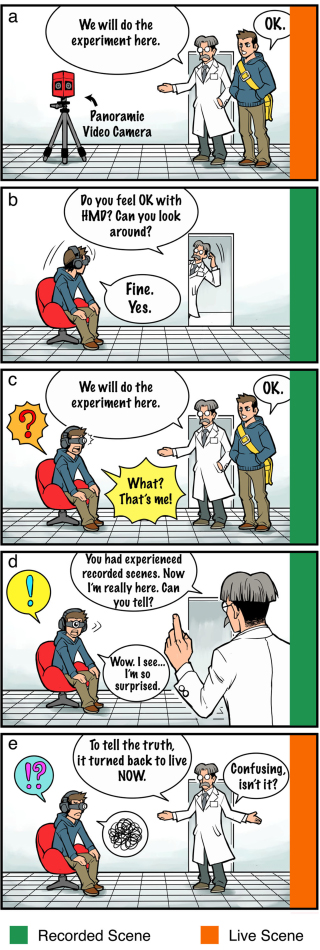Mar. 24, 2014
Substitutional Reality system
RIKEN No.: 08152, 08275
Inventors
Sohei Wakisaka, Keisuke Suzuki, and Naotaka Fujii (Laboratory for Adaptive Intelligence)
Background
What happens if the scenery in front of you is in fact from a very long time ago and the people walking around you do not actually exist...? How will our conviction about reality (CR) be affected if we can no longer distinguish between the events of the present and the past? This research team has developed a technology that enables us to work on such questions that existed only in the world of science fiction before.
Summary

The head mount display (HMD) to be worn by the participant shows the scene sequence of live scenes from the camera captured at the height of one's eyes and the past scenes previously recorded at the same location. By using a panorama video camera capable of recording all directions to capture the images from the past, the participant can look around for the scenes of the past freely just as he/she can for the live scene. In addition, the pre-recorded audio from the past is played through the headphone while the participant is experiencing the past scenes.
Under such conditions, it is impossible for the participant to distinguish between the live scenes and the scenes from the past. That is, the subjective reality experience itself is continuous, and the participant can be shown the live scenes and the past scenes that are switched flexibly. This mechanism to substitute the "reality" with one prepared beforehand without noticing the reality gap is called the Substitutional Reality (SR) technology.
The studies so far have revealed that the ways of cognitive function and communication sway quite dramatically when the reality of the participant is manipulated using the SR technology.
Merits
- Improvement and development as a general-purpose social experiment system, measurement of brain activities
- Expansion as a mode of interactive art or art performance
- Application in psychotherapy, etc.
References
- 1. US patent 9304585
